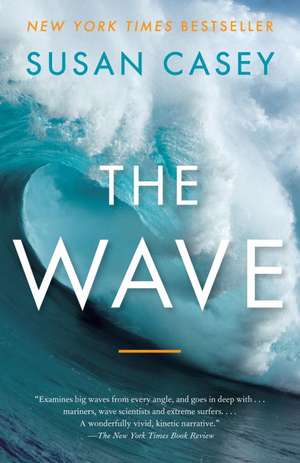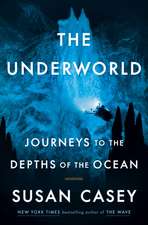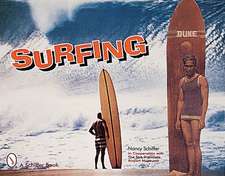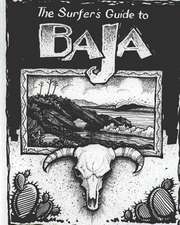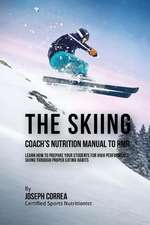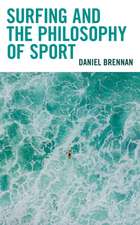The Wave: In Pursuit of the Rogues, Freaks, and Giants of the Ocean
Autor Susan Caseyen Limba Engleză Paperback – 30 apr 2011
Vezi toate premiile Carte premiată
Indies Choice Book Awards (2011)
A San Francisco Chronicle Best Book of the Year
In her astonishing new book Susan Casey captures colossal, ship-swallowing waves, and the surfers and scientists who seek them out.
For legendary surfer Laird Hamilton, hundred foot waves represent the ultimate challenge. As Susan Casey travels the globe, hunting these monsters of the ocean with Hamilton’s crew, she witnesses first-hand the life or death stakes, the glory, and the mystery of impossibly mammoth waves. Yet for the scientists who study them, these waves represent something truly scary brewing in the planet’s waters. With inexorable verve, The Wave brilliantly portrays human beings confronting nature at its most ferocious.
| Toate formatele și edițiile | Preț | Express |
|---|---|---|
| Paperback (2) | 69.78 lei 26-32 zile | +25.94 lei 7-13 zile |
| Vintage Publishing – 7 iul 2011 | 69.78 lei 26-32 zile | +25.94 lei 7-13 zile |
| Anchor Books – 30 apr 2011 | 114.05 lei 3-5 săpt. |
Preț: 114.05 lei
Nou
Puncte Express: 171
Preț estimativ în valută:
21.83€ • 22.70$ • 18.02£
21.83€ • 22.70$ • 18.02£
Carte disponibilă
Livrare economică 22 martie-05 aprilie
Preluare comenzi: 021 569.72.76
Specificații
ISBN-13: 9780767928854
ISBN-10: 0767928857
Pagini: 408
Ilustrații: 8-PAGE 4-COLOR INSERT; 4 MAPS
Dimensiuni: 134 x 201 x 23 mm
Greutate: 0.42 kg
Editura: Anchor Books
ISBN-10: 0767928857
Pagini: 408
Ilustrații: 8-PAGE 4-COLOR INSERT; 4 MAPS
Dimensiuni: 134 x 201 x 23 mm
Greutate: 0.42 kg
Editura: Anchor Books
Notă biografică
Susan Casey, author of New York Times bestseller The Devil’s Teeth: A True Story of Obsession and Survival Among America’s Great White Sharks, is editor in chief of O, The Oprah Magazine. She is a National Magazine Award-winning journalist whose work has been featured in the Best American Science and Nature Writing, Best American Sports Writing, and Best American Magazine Writing anthologies; and has appeared in Esquire, Sports Illustrated, Fortune, Outside, and National Geographic. Casey lives in New York City and Maui.
Extras
57.5° N, 12.7° W
175 MILES OFF THE COAST OF SCOTLAND
FEBRUARY 8, 2000
The clock read midnight when the hundred-foot wave hit the ship, rising from the North Atlantic out of the darkness. Among the ocean’s terrors a wave this size was the most feared and the least understood, more myth than reality—or so people had thought. This giant was certainly real. As the RRS Discovery plunged down into the wave’s deep trough, it heeled twenty- eight degrees to port, rolled thirty degrees back to starboard, then recovered to face the incoming seas. What chance did they have, the forty-seven scientists and crew aboard this research cruise gone horribly wrong? A series of storms had trapped them in the black void east of Rockall, a volcanic island nicknamed Waveland for the nastiness of its surrounding waters. More than a thousand wrecked ships lay on the seafloor below.
Captain Keith Avery steered his vessel directly into the onslaught, just as he’d been doing for the past five days. While weather like this was common in the cranky North Atlantic, these giant waves were unlike anything he’d encountered in his thirty years of experience. And worse, they kept rearing up from different directions. Flanking all sides of the 295-foot ship, the crew kept a constant watch to make sure they weren’t about to be sucker punched by a wave that was sneaking up from behind, or from the sides. No one wanted to be out here right now, but Avery knew their only hope was to remain where they were, with their bow pointed into the waves. Turning around was too risky; if one of these waves caught Discovery broadside, there would be long odds on survival. It takes thirty tons per square meter of force to dent a ship. A breaking hundred-foot wave packs one hundred tons of force per square meter and can tear a ship in half. Above all, Avery had to position Discovery so that it rode over these crests and wasn’t crushed beneath them.
He stood barefoot at the helm, the only way he could maintain traction after a refrigerator toppled over, splashing out a slick of milk, juice, and broken glass (no time to clean it up—the waves just kept coming). Up on the bridge everything was amplified, all the night noises and motions, the slamming and the crashing, the elevator-shaft plunges into the troughs, the frantic wind, the swaying and groaning of the ship; and now, as the waves suddenly grew even bigger and meaner and steeper, Avery heard a loud bang coming from Discovery’s foredeck. He squinted in the dark to see that the fifty-man lifeboat had partially ripped from its two-inch-thick steel cleats and was pounding against the hull.
Below deck, computers and furniture had been smashed into pieces. The scientists huddled in their cabins nursing bruises, black eyes, and broken ribs. Attempts at rest were pointless. They heard the noises too; they rode the free falls and the sickening barrel rolls; and they worried about the fact that a six-foot-long window next to their lab had already shattered from the twisting. Discovery was almost forty years old, and recently she’d undergone major surgery. The ship had been cut in half, lengthened by thirty-three feet, and then welded back together. Would the joints hold? No one really knew. No one had ever been in conditions like these.
One of the two chief scientists, Penny Holliday, watched as a chair skidded out from under her desk, swung into the air, and crashed onto her bunk. Holliday, fine boned, porcelain-doll pretty, and as tough as any man on board the ship, had sent an e- mail to her boyfriend, Craig Harris, earlier in the day. “This isn’t funny anymore,” she wrote. “The ocean just looks completely out of control.” So much white spray was whipping off the waves that she had the strange impression of being in a blizzard. This was Waveland all right, an otherworldly place of constant motion that took you nowhere but up and down; where there was no sleep, no comfort, no connection to land, and where human eyes and stomachs struggled to adapt, and failed.
Ten days ago Discovery had left port in Southampton, England, on what Holliday had hoped would be a typical three-week trip to Iceland and back (punctuated by a little seasickness perhaps, but nothing major). Along the way they’d stop and sample the water for salinity, temperature, oxygen, and other nutrients. From these tests the scientists would draw a picture of what was happening out there, how the ocean’s basic characteristics were shifting, and why.
These are not small questions on a planet that is 71 percent covered in salt water. As the Earth’s climate changes—as the inner atmosphere becomes warmer, as the winds increase, as the oceans heat up—what does all this mean for us? Trouble, most likely, and Holliday and her colleagues were in the business of finding out how much and what kind. It was deeply frustrating for them to be lashed to their bunks rather than out on the deck lowering their instruments. No one was thinking about Iceland anymore.
The trip was far from a loss, however. During the endless trains of massive waves, Discovery itself was collecting data that would lead to a chilling revelation. The ship was ringed with instruments; everything that happened out there was being precisely measured, the sea’s fury captured in tight graphs and unassailable numbers. Months later, long after Avery had returned everyone safely to the Southampton docks, when Holliday began to analyze these figures, she would discover that the waves they had experienced were the largest ever scientifically recorded in the open ocean. The significant wave height, an average of the largest 33 percent of the waves, was sixty-one feet, with frequent spikes far beyond that. At the same time, none of the state-of-the-art weather forecasts and wave models—the information upon which all ships, oil rigs, fisheries, and passenger boats rely—had predicted these behemoths. In other words, under this particular set of weather conditions, waves this size should not have existed. And yet they did.
175 MILES OFF THE COAST OF SCOTLAND
FEBRUARY 8, 2000
The clock read midnight when the hundred-foot wave hit the ship, rising from the North Atlantic out of the darkness. Among the ocean’s terrors a wave this size was the most feared and the least understood, more myth than reality—or so people had thought. This giant was certainly real. As the RRS Discovery plunged down into the wave’s deep trough, it heeled twenty- eight degrees to port, rolled thirty degrees back to starboard, then recovered to face the incoming seas. What chance did they have, the forty-seven scientists and crew aboard this research cruise gone horribly wrong? A series of storms had trapped them in the black void east of Rockall, a volcanic island nicknamed Waveland for the nastiness of its surrounding waters. More than a thousand wrecked ships lay on the seafloor below.
Captain Keith Avery steered his vessel directly into the onslaught, just as he’d been doing for the past five days. While weather like this was common in the cranky North Atlantic, these giant waves were unlike anything he’d encountered in his thirty years of experience. And worse, they kept rearing up from different directions. Flanking all sides of the 295-foot ship, the crew kept a constant watch to make sure they weren’t about to be sucker punched by a wave that was sneaking up from behind, or from the sides. No one wanted to be out here right now, but Avery knew their only hope was to remain where they were, with their bow pointed into the waves. Turning around was too risky; if one of these waves caught Discovery broadside, there would be long odds on survival. It takes thirty tons per square meter of force to dent a ship. A breaking hundred-foot wave packs one hundred tons of force per square meter and can tear a ship in half. Above all, Avery had to position Discovery so that it rode over these crests and wasn’t crushed beneath them.
He stood barefoot at the helm, the only way he could maintain traction after a refrigerator toppled over, splashing out a slick of milk, juice, and broken glass (no time to clean it up—the waves just kept coming). Up on the bridge everything was amplified, all the night noises and motions, the slamming and the crashing, the elevator-shaft plunges into the troughs, the frantic wind, the swaying and groaning of the ship; and now, as the waves suddenly grew even bigger and meaner and steeper, Avery heard a loud bang coming from Discovery’s foredeck. He squinted in the dark to see that the fifty-man lifeboat had partially ripped from its two-inch-thick steel cleats and was pounding against the hull.
Below deck, computers and furniture had been smashed into pieces. The scientists huddled in their cabins nursing bruises, black eyes, and broken ribs. Attempts at rest were pointless. They heard the noises too; they rode the free falls and the sickening barrel rolls; and they worried about the fact that a six-foot-long window next to their lab had already shattered from the twisting. Discovery was almost forty years old, and recently she’d undergone major surgery. The ship had been cut in half, lengthened by thirty-three feet, and then welded back together. Would the joints hold? No one really knew. No one had ever been in conditions like these.
One of the two chief scientists, Penny Holliday, watched as a chair skidded out from under her desk, swung into the air, and crashed onto her bunk. Holliday, fine boned, porcelain-doll pretty, and as tough as any man on board the ship, had sent an e- mail to her boyfriend, Craig Harris, earlier in the day. “This isn’t funny anymore,” she wrote. “The ocean just looks completely out of control.” So much white spray was whipping off the waves that she had the strange impression of being in a blizzard. This was Waveland all right, an otherworldly place of constant motion that took you nowhere but up and down; where there was no sleep, no comfort, no connection to land, and where human eyes and stomachs struggled to adapt, and failed.
Ten days ago Discovery had left port in Southampton, England, on what Holliday had hoped would be a typical three-week trip to Iceland and back (punctuated by a little seasickness perhaps, but nothing major). Along the way they’d stop and sample the water for salinity, temperature, oxygen, and other nutrients. From these tests the scientists would draw a picture of what was happening out there, how the ocean’s basic characteristics were shifting, and why.
These are not small questions on a planet that is 71 percent covered in salt water. As the Earth’s climate changes—as the inner atmosphere becomes warmer, as the winds increase, as the oceans heat up—what does all this mean for us? Trouble, most likely, and Holliday and her colleagues were in the business of finding out how much and what kind. It was deeply frustrating for them to be lashed to their bunks rather than out on the deck lowering their instruments. No one was thinking about Iceland anymore.
The trip was far from a loss, however. During the endless trains of massive waves, Discovery itself was collecting data that would lead to a chilling revelation. The ship was ringed with instruments; everything that happened out there was being precisely measured, the sea’s fury captured in tight graphs and unassailable numbers. Months later, long after Avery had returned everyone safely to the Southampton docks, when Holliday began to analyze these figures, she would discover that the waves they had experienced were the largest ever scientifically recorded in the open ocean. The significant wave height, an average of the largest 33 percent of the waves, was sixty-one feet, with frequent spikes far beyond that. At the same time, none of the state-of-the-art weather forecasts and wave models—the information upon which all ships, oil rigs, fisheries, and passenger boats rely—had predicted these behemoths. In other words, under this particular set of weather conditions, waves this size should not have existed. And yet they did.
Recenzii
“Examines big waves from every angle, and goes in deep with . . . mariners, wave scientists and extreme surfers. . . . [A] wonderfully vivid, kinetic narrative.” —The New York Times Book Review
“Immensely powerful, beautiful, addictive and, yes, incredibly thrilling. . . . Like a surfer who is happily hooked, the reader simply won’t be able to get enough of it.” —San Francisco Chronicle
“[An] adrenaline rush of a book. . . . As terrifying as it is awe inspiring.”
—People
“Casey’s descriptions of these monsters are as gripping in their own way as any mountaineering saga from the frozen peaks of Everest or K2.” —The Washington Post Book World
“Susan Casey's white-knuckle chronicle . . . delivers a thrill so intense you may never get in a boat again.” —Entertainment Weekly
“Reading The Wave is almost like riding one, paddling in the expositional surf of vivid imagery and colorful description thrown at you in ever-escalating surges.” —The Plain Dealer
“Casey does an exceptional job of explaining the natural forces (winds, currents, ocean-bottom shape) that create these daunting, at times fatal, surfing spots. . . . Terrific.” —Wall Street Journal
“Extraordinary. . . . I’m only allowed 800 words for this review. Here are a few: fascinating, heroic, dazzling, terrifying, amazing, unbelievable, mesmerizing, instructive, enlightening, superb. This is a . . . powerful, articulate ride into a world you never knew existed but that you will never, never forget.” —Richard Ellis, The Globe and Mail (Toronto)
“Utterly engrossing.” —Salon
“Something is stewing in our seas, and Susan Casey—traveling, and in some cases swimming, all around the world—is eager to find out what it is. Both a rollicking look at the ocean’s growing freakishness and a troubling examination of our ailing planet, The Wave gives new meaning to the term ‘immersion reporting.’” —Hampton Sides, author of Hellhound on His Trail
“[Casey] is a powerful voice in adventure writing. . . . Masterful.” —Outside
“Like the surfers and scientists she profiles, Casey lived and breathed giant waves for years. Casey combines an insane passion for craft with an uncanny ability to describe the indescribable. In The Wave she whisks the reader off to unimaginably surreal settings and puts them in the middle of mind-blowing scenarios. This book sucked me in like the undertow at Pipeline.” —Mary Roach, author of Stiff and Packing for Mars
“[A] breath-snatching thrill ride.” —Elle
“Compelling and wonderfully detailed. . . . An engrossing set of stories about the quest for bigger, stronger, more dangerous.” —Los Angeles Times
“A fabulous page-turner.” —NPR
“This book is adrenalin. You don’t want to surf the waves described herein. Read the book. It’s safer that way.” —Eddie Vedder
“Reading The Wave is the closest most of us will ever come to the sensation of riding, or even seeing, one of these towering monsters of the sea. It’s exhilarating, astonishing, and, not infrequently, terrifying. Brace yourself.” —Candice Millard, author of The River of Doubt
“A probing look at both the passionate and the pragmatic sides of these oceanic wonders. . . . Casey’s curiosity in learning about every conceivable aspect of waves makes for compelling reading, regardless of whether you look at waves as a great ride or with great concern.” —BookPage
“At once scary and fun, The Wave surprises at every turn.” —Elizabeth Kolbert, author of Field Notes from a Catastrophe
“[A] captivating hybrid—an intro to the mind-melting physics of waves and a ride-along with the scientists and surfers who chase after them.” —Men’s Journal
“The Wave is an amazing look at humble yet larger-than-life people who live by daring feats, honorable acts, and selfless denial. . . . Terrifying, beautiful, her prose is shot through with the haunting half-light of a storm.” —Doug Stanton, author of Horse Soldiers
“Immensely powerful, beautiful, addictive and, yes, incredibly thrilling. . . . Like a surfer who is happily hooked, the reader simply won’t be able to get enough of it.” —San Francisco Chronicle
“[An] adrenaline rush of a book. . . . As terrifying as it is awe inspiring.”
—People
“Casey’s descriptions of these monsters are as gripping in their own way as any mountaineering saga from the frozen peaks of Everest or K2.” —The Washington Post Book World
“Susan Casey's white-knuckle chronicle . . . delivers a thrill so intense you may never get in a boat again.” —Entertainment Weekly
“Reading The Wave is almost like riding one, paddling in the expositional surf of vivid imagery and colorful description thrown at you in ever-escalating surges.” —The Plain Dealer
“Casey does an exceptional job of explaining the natural forces (winds, currents, ocean-bottom shape) that create these daunting, at times fatal, surfing spots. . . . Terrific.” —Wall Street Journal
“Extraordinary. . . . I’m only allowed 800 words for this review. Here are a few: fascinating, heroic, dazzling, terrifying, amazing, unbelievable, mesmerizing, instructive, enlightening, superb. This is a . . . powerful, articulate ride into a world you never knew existed but that you will never, never forget.” —Richard Ellis, The Globe and Mail (Toronto)
“Utterly engrossing.” —Salon
“Something is stewing in our seas, and Susan Casey—traveling, and in some cases swimming, all around the world—is eager to find out what it is. Both a rollicking look at the ocean’s growing freakishness and a troubling examination of our ailing planet, The Wave gives new meaning to the term ‘immersion reporting.’” —Hampton Sides, author of Hellhound on His Trail
“[Casey] is a powerful voice in adventure writing. . . . Masterful.” —Outside
“Like the surfers and scientists she profiles, Casey lived and breathed giant waves for years. Casey combines an insane passion for craft with an uncanny ability to describe the indescribable. In The Wave she whisks the reader off to unimaginably surreal settings and puts them in the middle of mind-blowing scenarios. This book sucked me in like the undertow at Pipeline.” —Mary Roach, author of Stiff and Packing for Mars
“[A] breath-snatching thrill ride.” —Elle
“Compelling and wonderfully detailed. . . . An engrossing set of stories about the quest for bigger, stronger, more dangerous.” —Los Angeles Times
“A fabulous page-turner.” —NPR
“This book is adrenalin. You don’t want to surf the waves described herein. Read the book. It’s safer that way.” —Eddie Vedder
“Reading The Wave is the closest most of us will ever come to the sensation of riding, or even seeing, one of these towering monsters of the sea. It’s exhilarating, astonishing, and, not infrequently, terrifying. Brace yourself.” —Candice Millard, author of The River of Doubt
“A probing look at both the passionate and the pragmatic sides of these oceanic wonders. . . . Casey’s curiosity in learning about every conceivable aspect of waves makes for compelling reading, regardless of whether you look at waves as a great ride or with great concern.” —BookPage
“At once scary and fun, The Wave surprises at every turn.” —Elizabeth Kolbert, author of Field Notes from a Catastrophe
“[A] captivating hybrid—an intro to the mind-melting physics of waves and a ride-along with the scientists and surfers who chase after them.” —Men’s Journal
“The Wave is an amazing look at humble yet larger-than-life people who live by daring feats, honorable acts, and selfless denial. . . . Terrifying, beautiful, her prose is shot through with the haunting half-light of a storm.” —Doug Stanton, author of Horse Soldiers
Descriere
Casey follows a unique tribe of extreme surfers as they seek to conquer the holy grail of their sport, a 100-foot wave. In this mesmerizing account, their exploits are juxtaposed against scientists' urgent efforts to understand the destructive powers of waves.
Premii
- Indies Choice Book Awards Finalist, 2011
